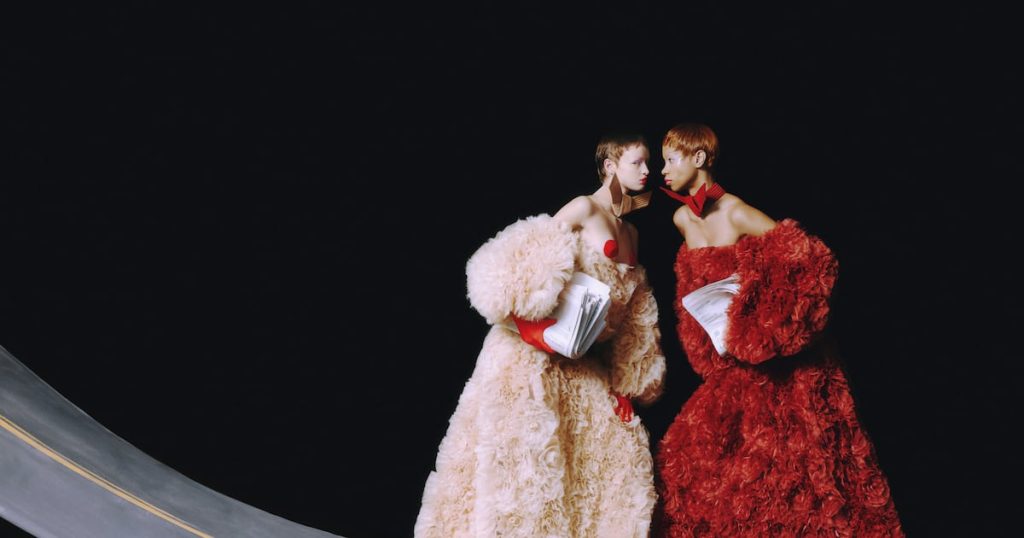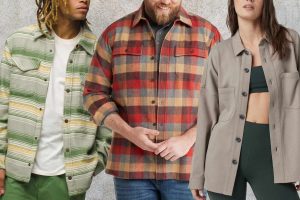Rafael Pavarotti is one of Katie Grand’s favourite collaborators. Grand, who describes the Brazilian photographer’s work as “mind-blowing,” has cast him for high-profile gigs like the Rihanna cover of Perfect. That’s high praise in fashion circles where Grand is considered one of the most influential magazine founders, editors and ‘super-stylists’ of her generation.
Even though she had worked with Pavarotti on several occasions before, Grand was bowled over by his latest feat of improvisation. When last-minute setbacks derailed the original plan for the shoot, the Belém-born photographer had less than three hours to pull everything together. Fortunately, he had long ago learnt to embrace gambiarra—the Brazilian knack for finding creative solutions on the fly.

Pavarotti and his longtime collaborator, Brazilian stylist George Krakowiak, see gambiarra as a source of national pride. So much so that the pair set out to celebrate it in an editorial for Acne Paper, in which Krakowiak fashioned colourful sculptures from broomsticks, swim rings and bin bags. The shoot highlights Pavarotti’s signature blend of chromatic mastery and theatrical storytelling — qualities that have helped him secure work from the likes of Dior, Ferragamo, Maison Margiela and H&M.
Up-and-coming Latin American photographers like Pavarotti are beginning to turn their lens on new subjects and settings, reimagining fashion’s visual language in the process. This diverse new wave of talent includes names like Mexico’s Enrique Leyva, Venezuelan Silvana Trevale and Guatemala’s Juan Brenner, image-makers who tend to bring not only fresh perspectives and cultural depth but desirable traits like adaptability and a strong work ethic to their growing roster of international clients.
It’s certainly not the first wave of Latin American talent to reach the upper echelons of the fashion industry. Most high-profile photographers who started their careers in the 1980s, 90s and 00s had to leave their home countries to get a big break, putting down roots in cities like New York, Milan, Paris and London.
Colombian legend Ruven Afanador, for example, has photographed Hollywood A-listers for magazines ranging from Vogue to Rolling Stone, while Peru’s Mariano Vivanco became a regular for Dolce & Gabbana’s campaigns. And before his career ended abruptly in 2018 amid accusations of sexual misconduct, Peruvian Mario Testino shot for a rollcall of luxury brands including Gucci, Versace and Chanel.
More recently, Argentina has produced a number of standout photographers with Sebastian Faena, Paola Kudacki and duo Sofia Sanchez and Mauro Mongiello, securing campaigns for the likes of Fendi, Estée Lauder and Missoni between them.
While these earlier waves of talent adhered to more conventional aesthetic frameworks, the next generation of photographers from Latin America has started to set a new tone, weaving deeply personal narratives into their work to reflect the industry’s growing focus on culture, community and representation.
Local subjects that resonate globally
Oaxaca-born and based Enrique Leyva us gaining recognition for his vibrant portraiture of Indigenous subjects set against urban and natural landscapes. The Mexican has worked with global brands such as Dior and Levi’s and featured in international editions of Vogue, GQ, and Esquire.

“Enrique’s work stood out to us for his vivid portrayal of colour, as well as his sensibility and keen consideration of his subjects,” said Wes Gordon, creative director of Carolina Herrera. In November, when the US brand presented its resort season in Mexico City, Leyva was commissioned to photograph the collection alongside fellow Mexican Khristio and New York-based, Argentinian Martina Keenan. This approach mirrored the 2023 show in Rio de Janeiro, where the brand partnered with photographer Hick Duarte and worked predominantly with Brazilian artists.
“Art directors and creatives are now more interested in working with talent tied to the story. Editorial projects might have been ahead in this, but even in commercial settings, we’re seeing photographers pitch deeply personal ideas that resonate globally,” says Pauline Magnenat, founder of Rocket Science Studio, a Paris-based talent agency representing photographers like Guatemalan Juan Brenner, London-based Venezuelan Silvana Trevale and Brazilian Rodrigo Oliveira.
Brenner’s Marchistas series for Nike, created for the 2021 Olympics, exemplifies this shift. The project captured Guatemala’s young athletes from race-walking, a sport that has become integral to the nation’s identity. Brenner spent a decade in New York working as a fashion photographer before returning to Guatemala to document these and other Indigenous subjects. His resulting works have been featured in the British Journal of Photography, Le Monde and Aperture.
Silvana Trevale broke through with a Vogue Italia story about Latin American immigration in the UK, created with close collaborator and Venezuelan stylist Daniela Benaim. The project’s popularity paved the way for an editorial in British Vogue, documenting London’s Latin Village in Seven Sisters and a story for US Vogue about fisherwoman from her home country. Trevale’s documentarian style has also been used in portraits for the Loewe Foundation and lensing activist Greta Thunberg for Elle.

Up-and-coming Brazilian talents have also been capturing the nuances of identity. Pedro Napolinário was determined to “portray Blackness beautifully” in response to what he saw as its absence in local magazines. The Rio de Janeiro native, whose clients include Nike, Adidas, Lacoste, Osklen and Farm Rio, cites Vogue Brazil regular Zee Nunes and documentary photographer Walter Firmo as key influences. “Firmo showed me how Blackness can be romantic and whimsical,” he said.
Last year, Napolinário shot two Dazed stories focused on local themes: one about Brazil’s Grauzerios subculture and another inspired by the La Virgen del Carmen festival in the Peruvian Andes, styled by Italian-Peruvian Giulia Revolo. He has also contributed to i-D and regularly shoots for Brazilian editions of Vogue, Glamour and Harper’s Bazaar.
New routes to international recognition
While most of these photographers aren’t yet shooting major campaigns for megabrands like Chanel or Dior, international projects do still help boost their local profile and create opportunities for work.
Napolinário believes his first story for UK-based Dazed in 2021 helped advance his career back home. “I started feeling more easily embraced by the [Brazilian] industry [after that],” he says.
A decade or so ago, it was even harder for some up-and-coming names to secure work locally. Paula Merlo, head of content for Vogue Brazil, remembers an industry early in her career that was historically dominated by a predictable roster of white male photographers. “Collaboration with emerging or local talent was rare, especially in Brazil,” she said.
Gradually, that started to change, thanks to social media “giving people a voice which meant brands had to adapt,” and “talent and celebrities wanting to be portrayed by someone who understands them.” Merlo highlights the work of Pavarotti, Mar+Vin (the name used by duo Marcos Florentino and Kelvin Yule) and Napolinário for injecting editorials with newfound creativity and diverse representation. She also credits photographers like trans woman Caia Ramalho and Mariana Maltoni for championing queer representation.

Attitudes didn’t shift overnight. Karla Martínez, head of content for Vogue Mexico, points to a time when photographers based in the US and Europe like Alexi Lubomirski (a Briton with Peruvian heritage), Ruven Afanador and Mariano Vivanco were regularly flown in for projects.
Leyva — like many of his peers — recalls trying to imitate the clean, polished European aesthetics emblematic of that earlier generation. “But we changed that,” he says, crediting Mexican photographer Dorian Ulises López for helping to make it happen.
It was the 2019 Vogue Mexico cover featuring Indigenous actress Yalitza Aparicio shot by Santiago and Mauricio Sierra that Levya believes set a milestone in reclaiming heritage narratives. Leyva’s cover of Oaxacan model Karen Vega for the same title came out in 2020, a few years before Mar+Vin captured Kamurape and Guarani Mbya model Zaya Guarani for Vogue Brazil.
However, not every photographer from the region built their careers on culturally rooted aesthetics.
Facing risks of typecasting and tokenism
Trailblazer Mariano Vivanco built his two-decades-long career on timeless, classically composed portraits and nudes, often in monochrome—an aesthetic closely aligned with the industry’s standards at the time of his debut.
“I’m very proud of my Latin heritage,” says Lima-born Vivanco who spent his youth moving between the US, New Zealand and Australia before settling in London in his early 20s. “[But] I’ve always considered myself a mix of all these places. I want my work to reflect diversity and multiculturalism—values shaped by how I grew up,” he adds, alluding to his earlier work for Dazed & Confused (now Dazed) alongside then-editor Nicola Formichetti.
“Traditional aspects of fashion photography aren’t all bad—some hold great value. The key is reconciling them and moving beyond a one-way-or-the-other mindset,” says Camila Fálquez, a New York-based photographer of Colombian heritage, born in Mexico. Her vibrant portraiture has landed her lookbook gigs for Baby Dior and Helmut Lang whilst her editiorial work, often highlighting the Latin LGBTQ+ community, has appeared in the Mexican and Spanish editions of Vogue.

Jacques Burga, a Lima-born photographer based in Paris for the last six years, concurs. “My aesthetic may not directly reflect Latin America, but an individual point of view is what makes each artist special,” he says. While his classic aesthetic has landed Burga Vanity Fair covers, he remains connected to his roots, having recently shot a campaign for Peruvian fashion designer Ani Alvarez Calderón and staged a photo exhibition in Lima.
Some creatives are understandably shaped by the long-held notion that grounding an artist’s work in their background risks typecasting—and, in turn, limits their opportunities.
Izack Morales worried about being boxed into one category as he noticed growing numbers of fellow Mexican fashion photographers exploring culturally rooted stories and underrepresented Indigenous communities. “I enjoy navigating those themes without letting them fully define my style. I’m part of this, but other things also inspire and spark my curiosity,” he says from his base in New York.
Krakowiak observes that Latin American artists abroad are often viewed through Eurocentric filters, with Brazilians reduced to clichés like samba, Rio, carnival or football. “There’s a wealth of creativity and narratives far beyond these associations,” he says. It was this frustration that helped inspire his exploration of gambiarra with Pavarotti. “Growing up in a [developing] country like Brazil…we are naturally inventive,” he adds.
The concept of gambiarra, though Brazilian, resonates across the entire region. “There’s a documentary quality, a sense of magical realism unique to Latin Americans. They capture bizarre yet natural situations that feel deeply Latin without relying on fashion. That’s what I love—it’s so resourceful,” says Colombia-born, Barcelona-based stylist Stephania Yepes, citing photographer collaborators like Dorian Ulises and Mar+Vin.
London-based Venezuelan multidisciplinary artist Victoria Ruiz shares this perspective. “When people say, ‘You [only] make stories about Latin America,’ I say yes—it’s a privilege to not have to. For me, avoiding these issues isn’t an option. [As a Venezuelan], it’s natural for me to see surrealism as part of life,” she explains, referencing Venezuela’s ongoing political and economic crisis.

“Few Venezuelans are in this space, and we have important stories to tell,” explains Ruiz, who shoots for Vogue Mexico and won the first Numéro+ Switzerland Photography Contest last year before being shortlisted for the BBA Photography Prize.
In addition to being typecast or expected to perpetuate the exoticisation of Latin America, photographers also face issues like tokenism, suggests Argentinian Camila Straschnoy, US partner and senior strategy director at Untold, a network of agencies operating across Latin America, focusing on communication strategies.
“While many creatives from the region bring an incredible Latin flair, others don’t—and that’s okay. Talent should be recognised and hired on merit, not based on nationality or appearance,” she says, emphasising that one’s Latin American identity should neither be a barrier nor a hollow checkbox exercise for brands looking to improve their diversity and inclusion record.
Daniel Peters, London-based founder of The Minority Report Group, echoes the need to move beyond tokenism.
“The industry has been hearing us speak for years about the need for better representation in order to bring a different lens, consideration and cultural nuance to the table, and whilst some are booking talent behind the lens to create the images…it still begs the questions as to whether we are doing enough,” says Peters.
“True progress requires consistent opportunities.”
Working in dynamic but challenging local hubs
For many, the quest for success raises the familiar question of whether relocation is needed. Sofia Malamute left Buenos Aires for New York at 19, convinced it was “the centre of the fashion world.” The move meant leaving family and friends behind, she says, but the sacrifice paid off. One of her first major gigs was shooting for Chanel’s Instagram, working closely with Karl Lagerfeld. Now 32, her clients include Prada, Saint Laurent and Marc Jacobs.
However, not all feel the need to relocate in today’s rapidly evolving industry where digital tools facilitate many aspects of work. Napolinário, Lopez and Leyva continue to work mainly from their home countries.
Still, Vogue Mexico’s Martínez notes that location can remain a barrier. “To secure certain contracts, it’s harder if you live in Oaxaca,” she explains, referring to Leyva’s hometown which is nearly 500 kilometres from Mexico City. It is his flexibility and willingness to travel to both regional and international hubs, Martinez suggests, that have helped him flourish.
Vivanco maintains that global success requires a presence in cities like Paris, London, Milan or New York where “fashion houses, magazines and platforms are concentrated.” This means newcomers must work their way up the ladder. “You have to pay your dues,” he warns. “Knowing how to lead a team of up to 80 people doesn’t happen overnight.”
International prestige isn’t the only measure of success. Across Latin America, many photographers are building profitable, fulfilling businesses in local fashion hubs, driven by growing demand from domestic, regional and sometimes international brands.
Take EgoEgo, a Santiago, Chile-based content agency launched in 2021 by stylist Natalia Schwarberger and photographer Nacho Rojas. Setting out to deliver locally produced, high-quality content as an alternative to traditional advertising agencies, the pair’s cost-effective approach has attracted H&M, Adidas, L’Oréal and Puma. But more often than not, it’s demand from local clients — in this case womenswear retailer IO Chile, retail giant Cencosud and denim label Wados — that sustains them.
In markets as large as Mexico, major retailers like Palacio de Hierro, Liverpool and budget chain Coppel regularly hire big local names like Khristio for campaigns. But for the country’s up-and-coming photographers, independent projects remain am important stepping stone. Denisse Hurrle, for instance, started with indie titles like Meow Magazine and 192, a foundation that led to work with L’Officiel, Steve Madden, Timberland and Nike.
Working exclusively in Latin America is certainly not without its challenges. “Fashion photography is undervalued in much of the region, with budgets far below US or European standards,” Magnenat says.
Mexico-based Paola Vivas, who worked in London for 13 years before moving back to her home country, believes that Latin American photography hubs lag global fashion capitals in other ways too, such as techniques and trends. Moreover, “financial instability [in local markets] adds another layer, with payments [from clients] often taking six months to a year, disrupting cash flow and stifling growth.”
Despite these and other challenges, many remain optimistic about future talent coming out of Latin America.
For Krakowiak, being embraced by the industry in London has sparked freedom and inspiration in countless ways, but the defiant solidarity that fuelled him back in Brazil is harder to find in Europe. It was local collaborators like Pavarotti, he says, who stood by him so that the pair were able to make “things happen despite an industry that prioritised commerce over art.”








